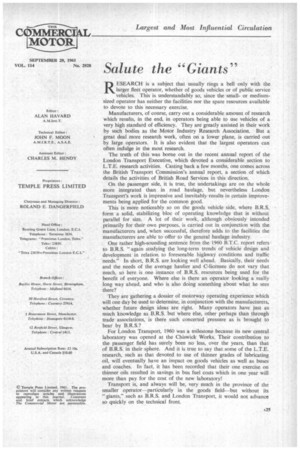Salute the "Giants"
Page 27

If you've noticed an error in this article please click here to report it so we can fix it.
RESEARCH is a subject that usually rings a bell only with the larger fleet operator, whether of goods vehicles or of public service vehicles. This is understandably so, since the smallor mediumsized operator has neither the facilities nor the spare resources available to devote to this necessary exercise.
Manufacturers, of course, carry out a considerable amount of research which results, in the end, in operators being able to use vehicles of a very high standard of efficiency. They are greatly assisted in their work by such bodies as the Motor Industry Research Association. But a great deal more research work, often on a lower plane, is carried out by large operators. It is also evident that the largest operators can often indulge in the most research.
The truth of this was borne out in the recent annual report of the London Transport Executive, which devoted a considerable section to L.T.E. research activities. Casting back a few months, one comes across the British Transport Commission's annual report, a section of which details the activities of British Road Services in this direction.
On the passenger side, it is true, the undertakings are on the whole more integrated than in road haulage, but nevertheless London Transport's work is impressive and inevitably results in certain improvements being applied for the common good.
This is more noticeably so on the goods vehicle side, where B.R.S. form a solid, stabilizing bloc of operating knowledge that is without parallel for size. A lot of their work, although obviously intended primarily for their own purposes, is carried out in conjunction with the manufacturers and, when successful, therefore adds to the facilities the manufacturers are able to offer to the general haulage industry.
One rather high-sounding sentence from the 1960 B.T.C. report refers to B.R.S. "again studying the long-term trends of vehicle design and development in relation, to foreseeable highway conditions and traffic needs." In short, B.R.S. are looking well ahead. Basically, their needs and the needs of the average haulier and C-licensee do not vary that much, so here is one instance of B.R.S. resources being used for the benefit of everyone. Where else is there an operator looking a really long way ahead, and who is also doing something about what he sees there?
They are gathering a dossier of motorway operating experience which will one day be used to determine, in conjunction with the manufacturers, whether future design ideas are right. Many operators have just as much knowledge as B.R.S. but where else, other perhaps than through trade associations, is there such concerted pressure as is brought to bear by B.R.S.?
For London Transport, 1960 was a milestone because its new central laboratory was opened at the Chiswick Works. Their contribution to the passenger field has surely been no less, over the years, than that of B.R.S. in their sphere. And it is true to say that some of the L.T.E. research, such as that devoted to use of thinner grades of lubricating oil, will eventually have an impact on goods vehicles as well as buses and coaches. In fact, it has been recorded that their one exercise on thinner oils resulted in savings in bus fuel costs which in one year will more than pay for the cost of the new laboratory!
Transport is, and always will be, very much in the province of the smaller operator—particularly in the goods field—but without its "giants," such as B.R.S. and London Transport, it would not advance so quickly on the technical front.




















































































































